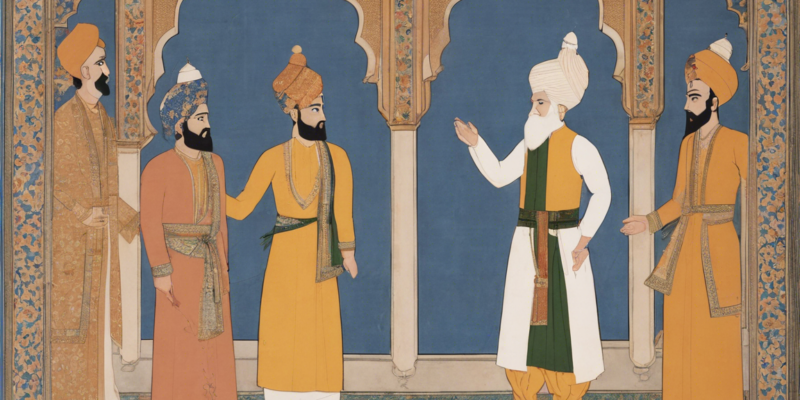In the grand tapestry of Mughal history, the scholarship, artistry, and legacy of Humayun, the second Mughal emperor, often stand in the shadow of his more illustrious successors like Akbar and Shah Jahan. However, Humayun’s influence on the Mughal Empire and his significant contributions to the arts and culture of the period are undeniable. One of the most intriguing aspects of Humayun’s reign is the Humayunnama, a manuscript that offers a unique insight into the life and times of this enigmatic ruler. In this article, we delve into the legacy of Humayunnama from a historical perspective, exploring its significance and impact on understanding the Mughal era.
Understanding the Humayunnama
Humayunnama, also known as the “Memoirs of Humayun” or “Tuzk-e-Humayuni,” is a historical account of the life and reign of Emperor Humayun. Commissioned by Humayun himself, the manuscript was written in Persian by his court historian, Gulbadan Begum, his half-sister. Completed in 1553, the Humayunnama provides a detailed narrative of Humayun’s struggles and triumphs, offering a rare glimpse into the political and cultural landscape of 16th-century India.
Significance of the Humayunnama
1. Historical Documentation: The Humayunnama serves as a crucial primary source for understanding the Mughal Empire’s early years, chronicling Humayun’s exile, his battles with Afghan warlords, and his eventual return to power.
2. Cultural Insights: Through the Humayunnama, we gain insights into the courtly life, social customs, and artistic patronage of the Mughal court during Humayun’s reign. The manuscript sheds light on the empire’s cosmopolitan character and its interactions with Persian, Central Asian, and Indian cultures.
3. Personal Perspective: Unlike many historical accounts of the period penned by court chroniclers, the Humayunnama offers a personal and intimate portrayal of Humayun as a ruler, father, and individual. Gulbadan Begum’s narrative humanizes Humayun, capturing his vulnerabilities, virtues, and complexities.
Themes and Motifs in the Humayunnama
1. Exile and Redemption: Central to the Humayunnama is the theme of exile and Humayun’s quest for redemption. His trials and tribulations during his years in exile in Persia and Sindh, and his eventual triumphant return to Delhi, form the narrative arc of the manuscript.
2. Dynastic Struggles: The Humayunnama delves into the intricate web of familial rivalries and power struggles within the Mughal dynasty, particularly the tensions between Humayun and his brothers Kamran and Askari.
3. Architectural Marvels: Humayun’s patronage of art and architecture is a prominent motif in the manuscript. The Humayunnama celebrates the construction of monuments like the Humayun’s Tomb in Delhi, a UNESCO World Heritage site and a masterpiece of Mughal architecture.
Influence of the Humayunnama on Mughal Historiography
The Humayunnama’s impact on Mughal historiography cannot be overstated. The manuscript set a precedent for the genre of “tuzk” or memoir in Mughal literature, influencing subsequent works like Babur’s “Baburnama” and Jahangir’s “Tuzk-e-Jahangiri.” Gulbadan Begum’s narrative style, blending personal anecdotes with political events, inspired future historians to adopt a more nuanced and humanistic approach to recording Mughal history.
Legacy of the Humayunnama Today
In contemporary times, the Humayunnama continues to captivate scholars, artists, and enthusiasts alike. Its vivid portrayal of Humayun’s era serves as a bridge to the past, offering a window into a bygone age of splendor, intrigue, and cultural exchange. The manuscript’s themes of resilience, leadership, and legacy resonate across centuries, making it a timeless testament to the enduring appeal of Mughal history.
Frequently Asked Questions (FAQs)
Q1: Who commissioned the Humayunnama?
A1: The Humayunnama was commissioned by Emperor Humayun himself and written by his half-sister, Gulbadan Begum.
Q2: What language was the Humayunnama written in?
A2: The Humayunnama was penned in Persian, the court language of the Mughal Empire.
Q3: When was the Humayunnama completed?
A3: The Humayunnama was completed in 1553 during the reign of Emperor Humayun.
Q4: What are some of the key themes in the Humayunnama?
A4: The Humayunnama explores themes of exile, redemption, dynastic struggles, and architectural patronage.
Q5: How has the Humayunnama influenced Mughal historiography?
A5: The Humayunnama set a precedent for memoir writing in the Mughal court and inspired future historians to adopt a more personal and nuanced approach to recording history.
Q6: What is the significance of Humayun’s Tomb mentioned in the Humayunnama?
A6: Humayun’s Tomb, celebrated in the Humayunnama, is a UNESCO World Heritage site and a masterpiece of Mughal architecture, symbolizing Humayun’s patronage of the arts.
Q7: Is the Humayunnama still relevant today?
A7: Yes, the Humayunnama continues to be a vital source for scholars studying the Mughal Empire and offers valuable insights into the cultural and political milieu of Humayun’s era.
Q8: Who was Gulbadan Begum, the author of the Humayunnama?
A8: Gulbadan Begum was Emperor Humayun’s half-sister and a prominent figure in the Mughal court. She was known for her literary talents and her role as a chronicler of Mughal history.
Conclusion
In conclusion, the Humayunnama stands as a testament to the rich tapestry of Mughal history, offering a nuanced and intimate portrayal of Emperor Humayun and his times. As a work of historical scholarship, cultural documentation, and literary artistry, the Humayunnama continues to enthrall and enlighten audiences, bridging the gap between past and present. Through its pages, we unravel the legacy of Humayun, a monarch whose life and reign left an indelible mark on the history of the Indian subcontinent.

